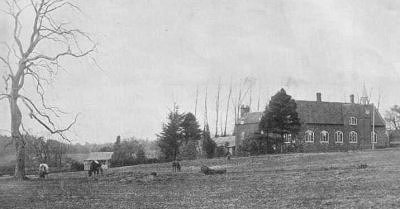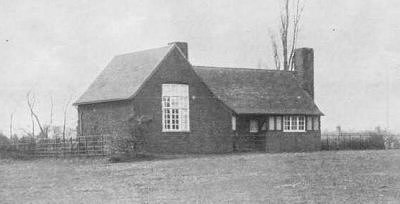- The records show that the
founder of the Foundation was one Antony Hall, Yeoman of Snettisham,
who lived in the village during the late 17th and early 18th
century.
- A married man, he lived
with his wife and their three sons and a daughter in a house known
as Cherry Hill with 5 acres of paddock. He also owned other freehold
land in Snettisham, Heacham and Norwich.
- In 1708 was taken ill and
as he lay sick he gave serious thought as what to do with his
worldly goods in the event of his death. His wife had already died
and he did not get on well with his children, but did approve of his
grandchildren. He was a much-travelled man and realised the value of
being able to read and write. He also had a strong affinity for
Snettisham and its inhabitants and realised that he could perhaps
help the poor of the village in the their education.
- In September 1708 he had
his will drawn up and witnessed, in the presence of Margaret and
James Disciple and Eliza Good.
- Antony Hall died on 14th
October 1708 and later that year his will was read.
- In his will his eldest son
Thomas was left 5 shillings if he came and asked for it, along with £5 for his son's apprenticeship. His second son, Antony, a father
of two, was to receive 40 shillings per year for life. His youngest
son and daughter, still of school age were placed with guardians in
Norwich and they were each given 5 a year to support them.
|

Hall's Grammar School Snettisham
|
- The bulk of his estate,
including all land and properties, were to be used to set up a trust
to supply funding for an endowed school in the village. This would
be a good country grammar school.
- The conditions set out in
the will stated that the school should take care of the proper
education of 20 poor boys of Snettisham whose parents occupied
property of not worth more than £20 and whose chattels did not
exceed £400 in assessed value. No other free scholars would be
taken unless they were descendants of Antony Hall but the school
could take any number of fee- paying scholars.
- From 1708 to 1791 nothing
was done to implement the wishes of the will regards the school. The
land and property had by now passed to Antony's granddaughter,
Francis Dolman and then to the Styleman family. By this time the
Hall's family in Snettisham had died out.
- In 1792, the local vicar
and a group of local residents led by Robert Foster took the case to
court to get the wishes of the will moving in respect of the
provision for a school. It took eight years, a very complicated and
expensive court case and much documentation before judgement was
given in their favour.
- In August 1800, nearly a
hundred years after Antony Hall's death, a full account was placed
before the Attorney General and the school was ready to come into
existence.
- During this time Antony's
house had fallen into disrepair and was worth very little and taxes
had taken a major share of capital left. The final amount left was
£409 9s 8d and the land owned in Snettisham. No school to occupy
and barely enough money to build a new one.
- In 1801 the first Board of
governor's was appointed to govern the Foundation. The first
Governors were Henry Styleman, James Lay, Thomas Rand, Charles
Snell, James Pretty, George Grant, Edmund Rolfe, James Coldman,
Richard Ayton Lee and William Davy.
- In April 1802 the governors
appointed a Mr Whitty, a surveyor who had drawn up plans for the new
school, as the Headmaster of the school.
|

The Sanatorium Snettisham
|
- Legal and financial
problems held up the building of the school on what is now Kenside
and it was not completed until 1805. Once built the financial
capital left to rum the school was £35 16s 9d.
- 20 village poor boys were
duly granted free education along with some fee paying students so
the Hall's Grammar School was finally up and running.
- Records show that the
Governors purchased an iron chest, with padlocks for the Foundations
documentation for the princely sum of 8s 8d. This chest, with much
of this documentation is still in our possession but minus the
padlocks!
- In 1854 after many ups and
downs, in terms of finance, numbers and academic successes the
school reaches a low point and following the retirement of Mr Whitty
after 50 years as headmaster, the school temporarily closes.
- The school reopens again
with a Mr Lubbock in charge, a new and much wider curriculum and a
new energy. Boarders, who were fee paying greatly increased and so
did the income and soon there were 50 pupils on roll. By now
accommodation was very limited and the school understaffed to meet
this new success.
- In 1858 a loan was taken
out to improve dormitory and classroom provision and for the
employment of two new assistants to help Mr Lubbock.
- By 1873 after many
successful wars the school began to suffer as a result of the
increasing number of Church and School Board schools opening in the
county. Our own Primary school was now competing for the same
children.
- In 1875 the school closed
again and reopened later in 1875 a under the new endowed Scheme
under the headship of Mr F.W.H. Palmer. Under this system the school
was paid a capitation grant to every Norfolk scholar attending. The
system of free education to Snettisham boys had been annulled and
was reinstated with scholarships for which they were partly
sponsored.

Map showing grounds and school
|

Plan of Hall's Grammar School
|
- In the ensuing years
fluctuating rolls, poor and inefficient teaching, limited classroom
and dormitory space posed serious problems. To combat this the
school was extended with new classrooms, dormitory and sanatorium.
The Prince of Wales gave funds for a new gymnasium. By 1897 the
school reached an all time high with 81 pupils, day and boarders on
its books. The quality of student was not always good but it kept
the Foundation solvent.
- By 1902 things had taken a
turn for the worse with the implementation of the new education act,
the opening of King Edward Grammar School in Kings Lynn, and some
poor financial investments.
- The school struggles on for
10 more years with very little help from Board of Education. In
1912, Mr Palmer tended his resignation and in 1913 the Board of
Education finally forces the closure of the Hall's Grammar School.
Snettisham boys would now be awarded scholarships to attend the
Grammar School in Kings Lynn.
- In December 1914 a public
inquiry initiated by the villagers of Snettisham looked into the
closure of the school. It was evident that Hall's Grammar School did
not fit into the Norfolk plan and was in fact an embarrassment to
them. However, the inquest did prove successful on one front. The
County Council wanted the land and assets sold and invested in
Consols. Instead the inquiry founded with the villagers who wanted
to form a Hall's Exhibition Charitable Trust, which would benefit
the education of Snettisham boys, or girls, if funds allowed it, and
give scholarships to Lynn or any other Grammar School.
- In 1915 the Charity
Commission produced the scheme, framed by the Board of Education
under the Endowed Schools Acts 1869, 1873 and 1874 for the amendment
of the scheme regulating Hall's Grammar School, Snettisham. The
Hall's Exhibition Foundation was now officially formed. It was to be
managed by a Board of Governors consisting of four County Council
elected representatives, four Parish Council elected representatives
and two Co-opted members.
- At this time it is recorded
on the Scheme that the Foundation owned School Buildings and part of
the playing field, Headmasters House and various pieces of land
totalling approximately 50 acres. This includes a piece of land
known as the Carr Stone quarry and Carr Pit Piece (sub let to E.
LycettGreen for 16 years) which would later prove to be our most
valuable asset. Investments at the time were in the region of £1400
bringing in a yearly income of £40 per annum.
- Some income was obtained
during the war as the Army used the school for the billeting of
soldiers. Following this there was no income from the school and a
pension had to be paid to Mr Palmer.
- On 19th May 1920 the
School, Headmasters House, Cricket Pavilion and Bungalow (old
Sanatorium) and 7 acres of land were put up for auction. This was
successfully sold and the school demolished to make way for much
needed new housing, which is now the Kenside estate. The only
remaining building, which is still occupied, is the old Sanatorium
at the top end of Kenside.
- The Ken Hill Estate also
purchased 15 acres of land they had been renting from the
Foundation.
- Capital from these sales
and the increasing royalties from the Carrstone Pit, were invested
and the interest used to fund the scholarships.
- The building boom of the
1950's saw a rapid rise in the royalties from the quarry as the need
for carrstone and other building material increased. This meant that
the Foundation's income was now far exceeding the scholarships that
were being given. The governors approached the Charity Commission to
revise their scheme to allow for greater scope with their bursaries.
- In 1974 the new scheme
allowed beneficiaries from outside the Parish to be considered and
the age group widened to run from the beginning of secondary
schooling, up to the age of 25 years, so that University and post
graduate students could benefit. It also allowed the Foundation to
make grants to groups as well as individuals.
- The disappointing aspect of
the scheme was that the Foundation was unable to make grants to the
local village junior school as the pupils were below the age that
grants were permitted.
- Stock market fluctuations
have seen a significant decline in the value of the Foundations
capital, which is only now starting to recover to the earlier high
level.
- The reorganisation of
Primary and Secondary Schooling in Norfolk from September 2004 will
mean for the first time that Snettisham. Primary School will be able
to receive financial assistance from the Foundation, as they will be
catering for 11 year olds.
-
2004 will also see the
exhaustion of carrstone from the Foundations quarry, the royalties
of which have swelled the capital invested by the Foundation.
-
2006 grant
of £20,000 awarded to Smithdon High School to enable Special Status
in Mathematics and Computing.
-
2008
educational grants exceeding £60,000 are allocated to Snettisham
groups and individuals.
-
2009 The
foundation awards a grant of £52,000 to Snettisham Primary School to
help towards the costs of replacing the old canteen and dining hall
with a new, modern building. This will be adapted as a
computer/classroom.
-
2012
Expansion of the quarry into adjoining Ken Hill land for future
extraction of carrstone.
-
2013 The
last of our carrstone is removed from our part of the quarry. The
lease for carrstone extraction is extended to 2028 on Ken Hill land.
-
2020 £9000 grant awarded to Snettisham Primary School for 18 laptop computers for home learning for Year 6 pupils during COVID restrictions.
|